Branding in Social Marketing and OD: Research Report
VerifiedAdded on 2020/03/28
|19
|4602
|35
Report
AI Summary
This report delves into the impact of branding activities within social marketing campaigns on organizational development (OD). It begins by outlining the problem statement, research objectives, and justification for the project, emphasizing the non-profit motives of social marketing. The report explores the concepts of branding and social marketing, highlighting how branding strategies, including individual and umbrella branding, are employed in social marketing contexts. It uses examples like the Greenstar contraceptive brand to illustrate these strategies. The study then examines the impact of branding through social marketing on OD, focusing on customer acquisition, relationship development, and profitability. A conceptual framework and research hypotheses are presented, followed by a discussion of the research methodology, including research philosophy, design, data collection, and analysis. The report concludes by emphasizing the role of social media and communication tools in enhancing customer relationships and driving organizational success. The research aims to understand how branding in social marketing influences customer behavior and contributes to long-term organizational goals.
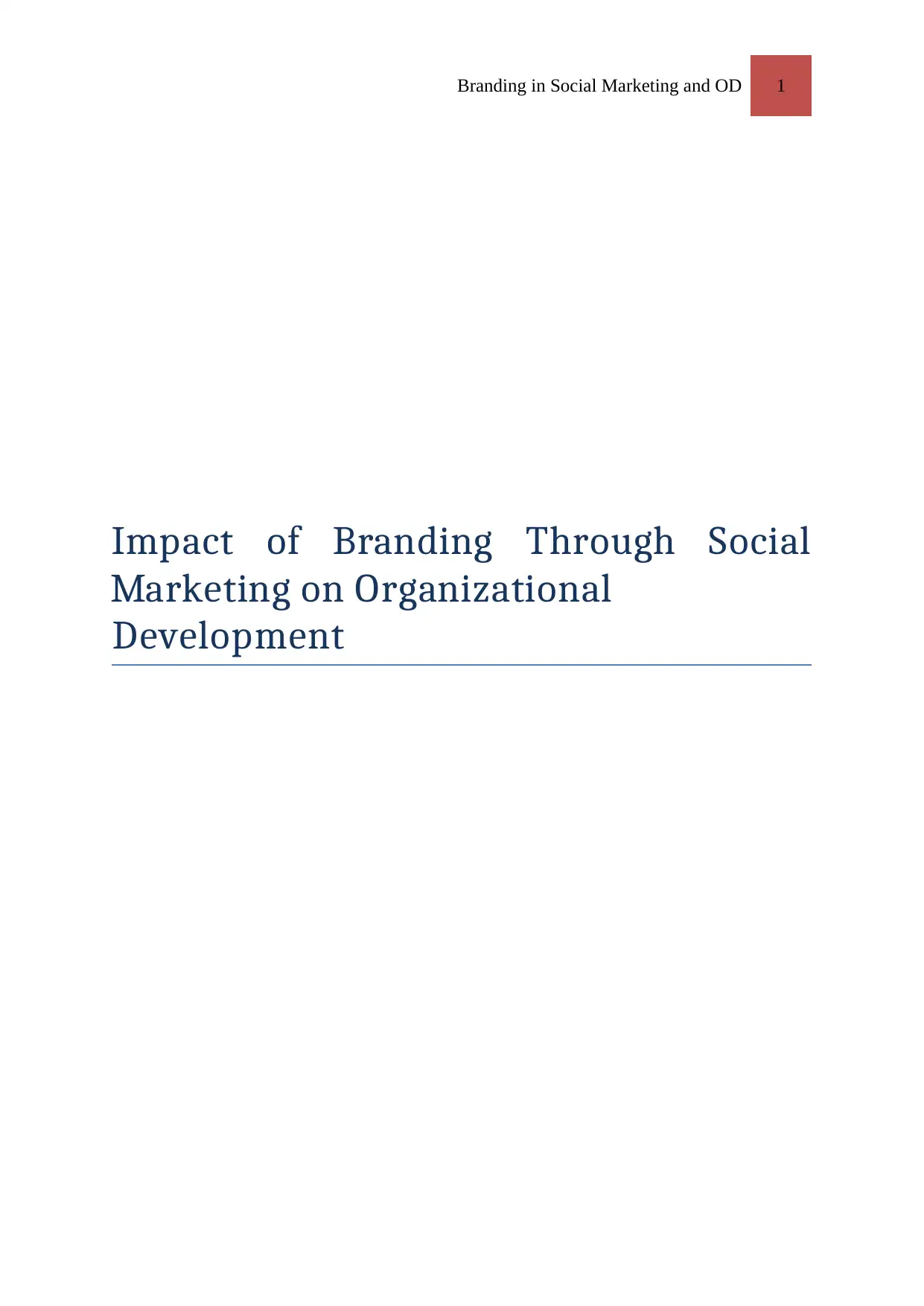
Branding in Social Marketing and OD 1
Impact of Branding Through Social
Marketing on Organizational
Development
Impact of Branding Through Social
Marketing on Organizational
Development
Paraphrase This Document
Need a fresh take? Get an instant paraphrase of this document with our AI Paraphraser
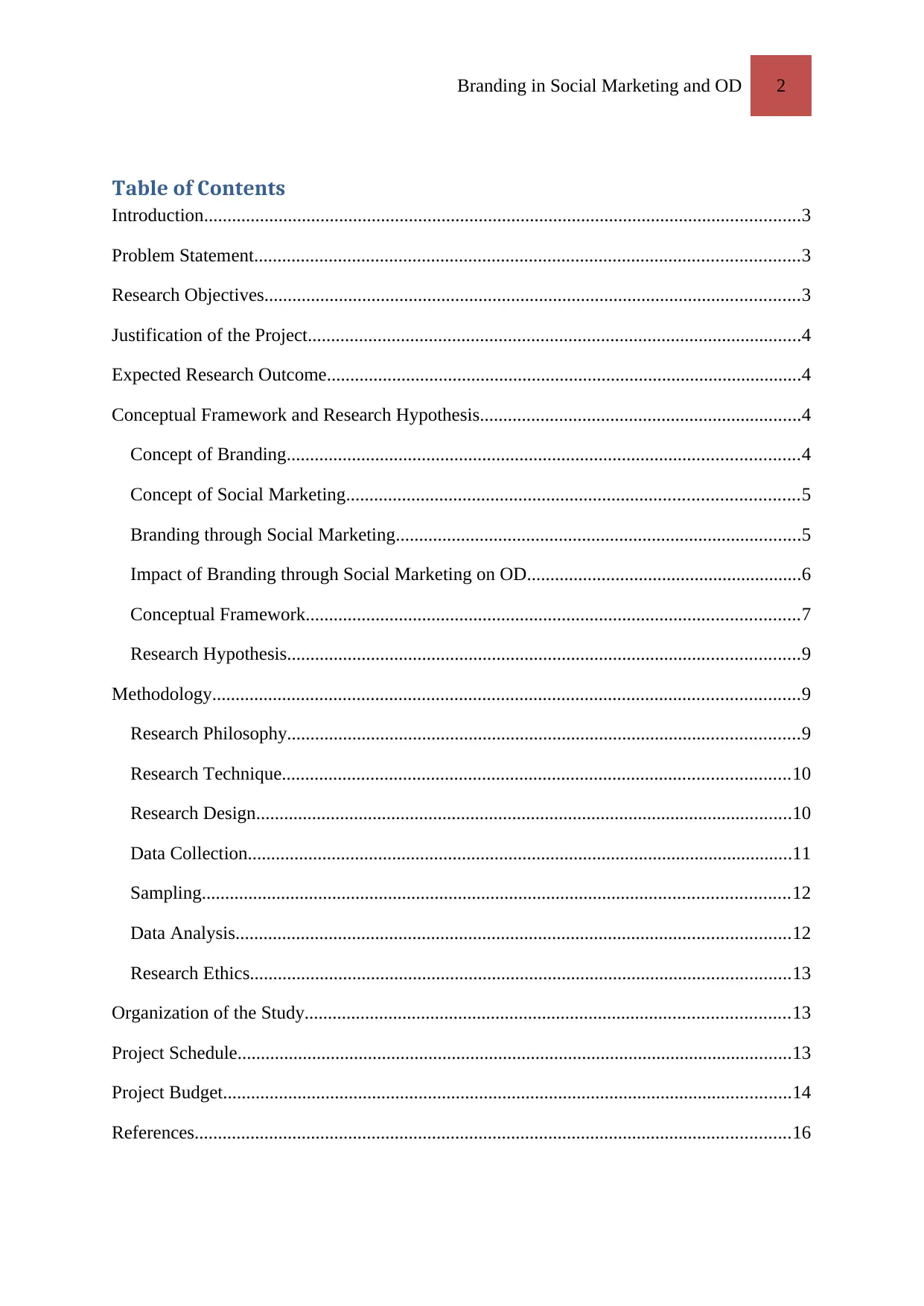
Branding in Social Marketing and OD 2
Table of Contents
Introduction................................................................................................................................3
Problem Statement.....................................................................................................................3
Research Objectives...................................................................................................................3
Justification of the Project..........................................................................................................4
Expected Research Outcome......................................................................................................4
Conceptual Framework and Research Hypothesis.....................................................................4
Concept of Branding..............................................................................................................4
Concept of Social Marketing.................................................................................................5
Branding through Social Marketing.......................................................................................5
Impact of Branding through Social Marketing on OD...........................................................6
Conceptual Framework..........................................................................................................7
Research Hypothesis..............................................................................................................9
Methodology..............................................................................................................................9
Research Philosophy..............................................................................................................9
Research Technique.............................................................................................................10
Research Design...................................................................................................................10
Data Collection.....................................................................................................................11
Sampling..............................................................................................................................12
Data Analysis.......................................................................................................................12
Research Ethics....................................................................................................................13
Organization of the Study........................................................................................................13
Project Schedule.......................................................................................................................13
Project Budget..........................................................................................................................14
References................................................................................................................................16
Table of Contents
Introduction................................................................................................................................3
Problem Statement.....................................................................................................................3
Research Objectives...................................................................................................................3
Justification of the Project..........................................................................................................4
Expected Research Outcome......................................................................................................4
Conceptual Framework and Research Hypothesis.....................................................................4
Concept of Branding..............................................................................................................4
Concept of Social Marketing.................................................................................................5
Branding through Social Marketing.......................................................................................5
Impact of Branding through Social Marketing on OD...........................................................6
Conceptual Framework..........................................................................................................7
Research Hypothesis..............................................................................................................9
Methodology..............................................................................................................................9
Research Philosophy..............................................................................................................9
Research Technique.............................................................................................................10
Research Design...................................................................................................................10
Data Collection.....................................................................................................................11
Sampling..............................................................................................................................12
Data Analysis.......................................................................................................................12
Research Ethics....................................................................................................................13
Organization of the Study........................................................................................................13
Project Schedule.......................................................................................................................13
Project Budget..........................................................................................................................14
References................................................................................................................................16

Branding in Social Marketing and OD 3
⊘ This is a preview!⊘
Do you want full access?
Subscribe today to unlock all pages.

Trusted by 1+ million students worldwide
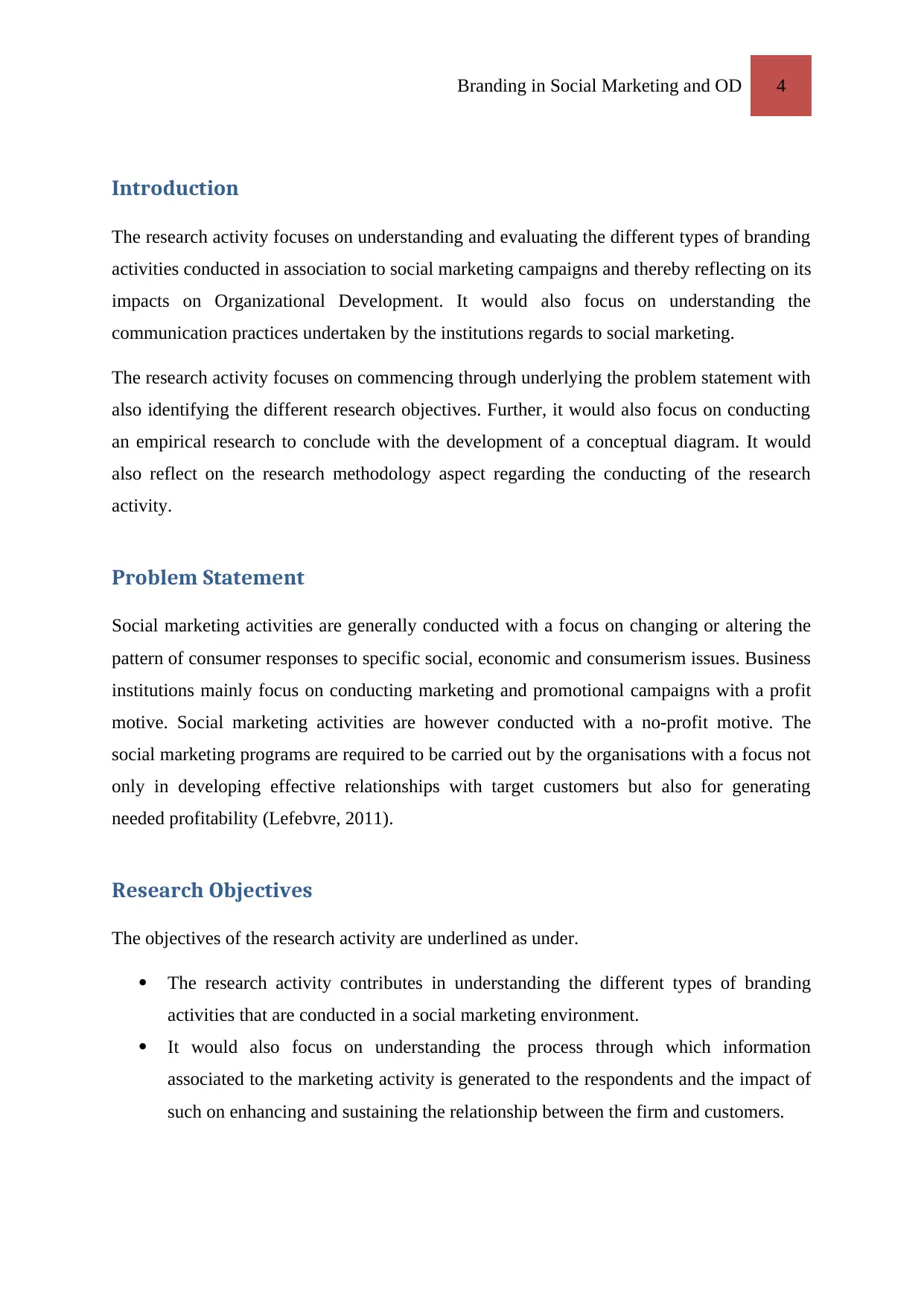
Branding in Social Marketing and OD 4
Introduction
The research activity focuses on understanding and evaluating the different types of branding
activities conducted in association to social marketing campaigns and thereby reflecting on its
impacts on Organizational Development. It would also focus on understanding the
communication practices undertaken by the institutions regards to social marketing.
The research activity focuses on commencing through underlying the problem statement with
also identifying the different research objectives. Further, it would also focus on conducting
an empirical research to conclude with the development of a conceptual diagram. It would
also reflect on the research methodology aspect regarding the conducting of the research
activity.
Problem Statement
Social marketing activities are generally conducted with a focus on changing or altering the
pattern of consumer responses to specific social, economic and consumerism issues. Business
institutions mainly focus on conducting marketing and promotional campaigns with a profit
motive. Social marketing activities are however conducted with a no-profit motive. The
social marketing programs are required to be carried out by the organisations with a focus not
only in developing effective relationships with target customers but also for generating
needed profitability (Lefebvre, 2011).
Research Objectives
The objectives of the research activity are underlined as under.
The research activity contributes in understanding the different types of branding
activities that are conducted in a social marketing environment.
It would also focus on understanding the process through which information
associated to the marketing activity is generated to the respondents and the impact of
such on enhancing and sustaining the relationship between the firm and customers.
Introduction
The research activity focuses on understanding and evaluating the different types of branding
activities conducted in association to social marketing campaigns and thereby reflecting on its
impacts on Organizational Development. It would also focus on understanding the
communication practices undertaken by the institutions regards to social marketing.
The research activity focuses on commencing through underlying the problem statement with
also identifying the different research objectives. Further, it would also focus on conducting
an empirical research to conclude with the development of a conceptual diagram. It would
also reflect on the research methodology aspect regarding the conducting of the research
activity.
Problem Statement
Social marketing activities are generally conducted with a focus on changing or altering the
pattern of consumer responses to specific social, economic and consumerism issues. Business
institutions mainly focus on conducting marketing and promotional campaigns with a profit
motive. Social marketing activities are however conducted with a no-profit motive. The
social marketing programs are required to be carried out by the organisations with a focus not
only in developing effective relationships with target customers but also for generating
needed profitability (Lefebvre, 2011).
Research Objectives
The objectives of the research activity are underlined as under.
The research activity contributes in understanding the different types of branding
activities that are conducted in a social marketing environment.
It would also focus on understanding the process through which information
associated to the marketing activity is generated to the respondents and the impact of
such on enhancing and sustaining the relationship between the firm and customers.
Paraphrase This Document
Need a fresh take? Get an instant paraphrase of this document with our AI Paraphraser
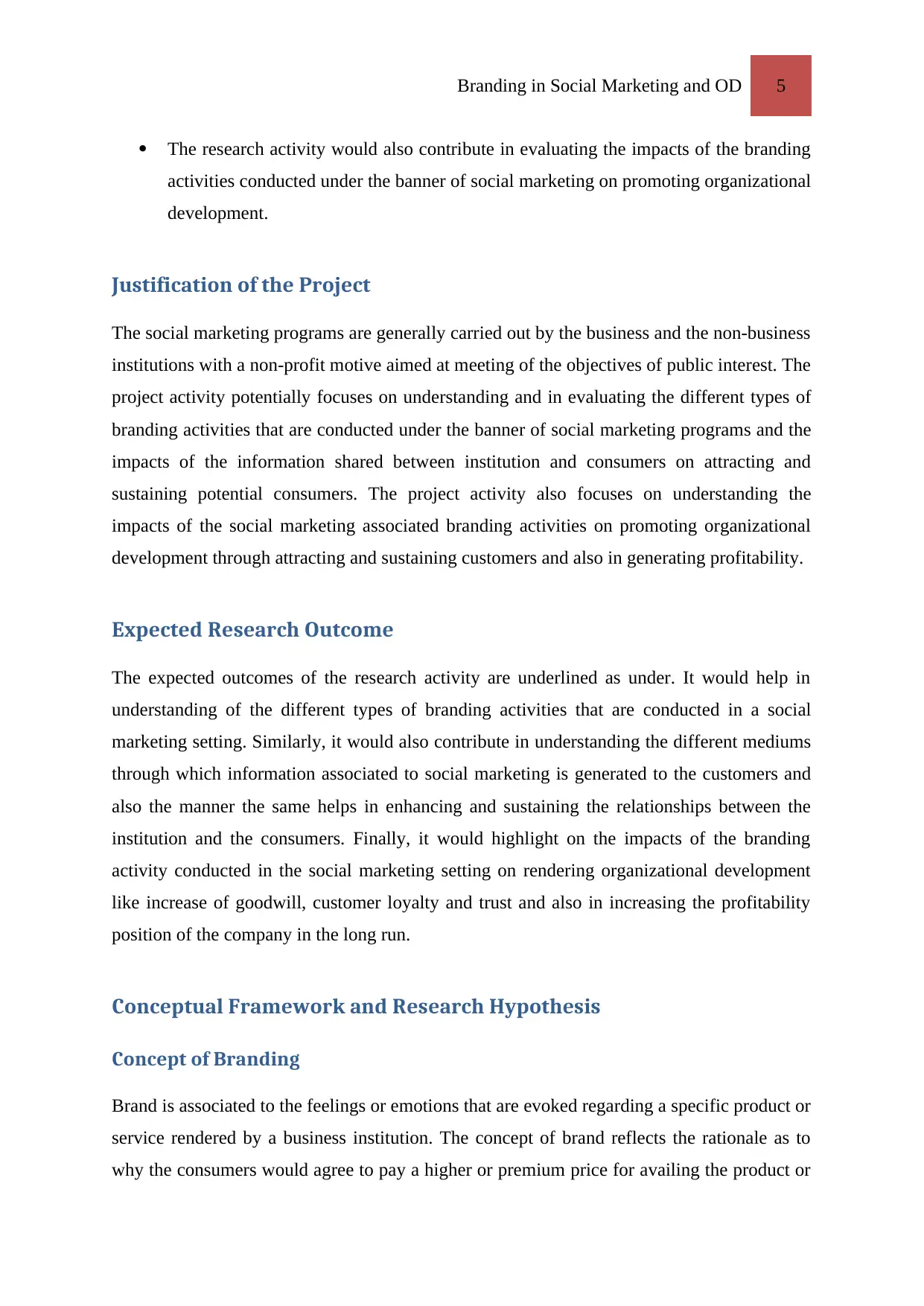
Branding in Social Marketing and OD 5
The research activity would also contribute in evaluating the impacts of the branding
activities conducted under the banner of social marketing on promoting organizational
development.
Justification of the Project
The social marketing programs are generally carried out by the business and the non-business
institutions with a non-profit motive aimed at meeting of the objectives of public interest. The
project activity potentially focuses on understanding and in evaluating the different types of
branding activities that are conducted under the banner of social marketing programs and the
impacts of the information shared between institution and consumers on attracting and
sustaining potential consumers. The project activity also focuses on understanding the
impacts of the social marketing associated branding activities on promoting organizational
development through attracting and sustaining customers and also in generating profitability.
Expected Research Outcome
The expected outcomes of the research activity are underlined as under. It would help in
understanding of the different types of branding activities that are conducted in a social
marketing setting. Similarly, it would also contribute in understanding the different mediums
through which information associated to social marketing is generated to the customers and
also the manner the same helps in enhancing and sustaining the relationships between the
institution and the consumers. Finally, it would highlight on the impacts of the branding
activity conducted in the social marketing setting on rendering organizational development
like increase of goodwill, customer loyalty and trust and also in increasing the profitability
position of the company in the long run.
Conceptual Framework and Research Hypothesis
Concept of Branding
Brand is associated to the feelings or emotions that are evoked regarding a specific product or
service rendered by a business institution. The concept of brand reflects the rationale as to
why the consumers would agree to pay a higher or premium price for availing the product or
The research activity would also contribute in evaluating the impacts of the branding
activities conducted under the banner of social marketing on promoting organizational
development.
Justification of the Project
The social marketing programs are generally carried out by the business and the non-business
institutions with a non-profit motive aimed at meeting of the objectives of public interest. The
project activity potentially focuses on understanding and in evaluating the different types of
branding activities that are conducted under the banner of social marketing programs and the
impacts of the information shared between institution and consumers on attracting and
sustaining potential consumers. The project activity also focuses on understanding the
impacts of the social marketing associated branding activities on promoting organizational
development through attracting and sustaining customers and also in generating profitability.
Expected Research Outcome
The expected outcomes of the research activity are underlined as under. It would help in
understanding of the different types of branding activities that are conducted in a social
marketing setting. Similarly, it would also contribute in understanding the different mediums
through which information associated to social marketing is generated to the customers and
also the manner the same helps in enhancing and sustaining the relationships between the
institution and the consumers. Finally, it would highlight on the impacts of the branding
activity conducted in the social marketing setting on rendering organizational development
like increase of goodwill, customer loyalty and trust and also in increasing the profitability
position of the company in the long run.
Conceptual Framework and Research Hypothesis
Concept of Branding
Brand is associated to the feelings or emotions that are evoked regarding a specific product or
service rendered by a business institution. The concept of brand reflects the rationale as to
why the consumers would agree to pay a higher or premium price for availing the product or
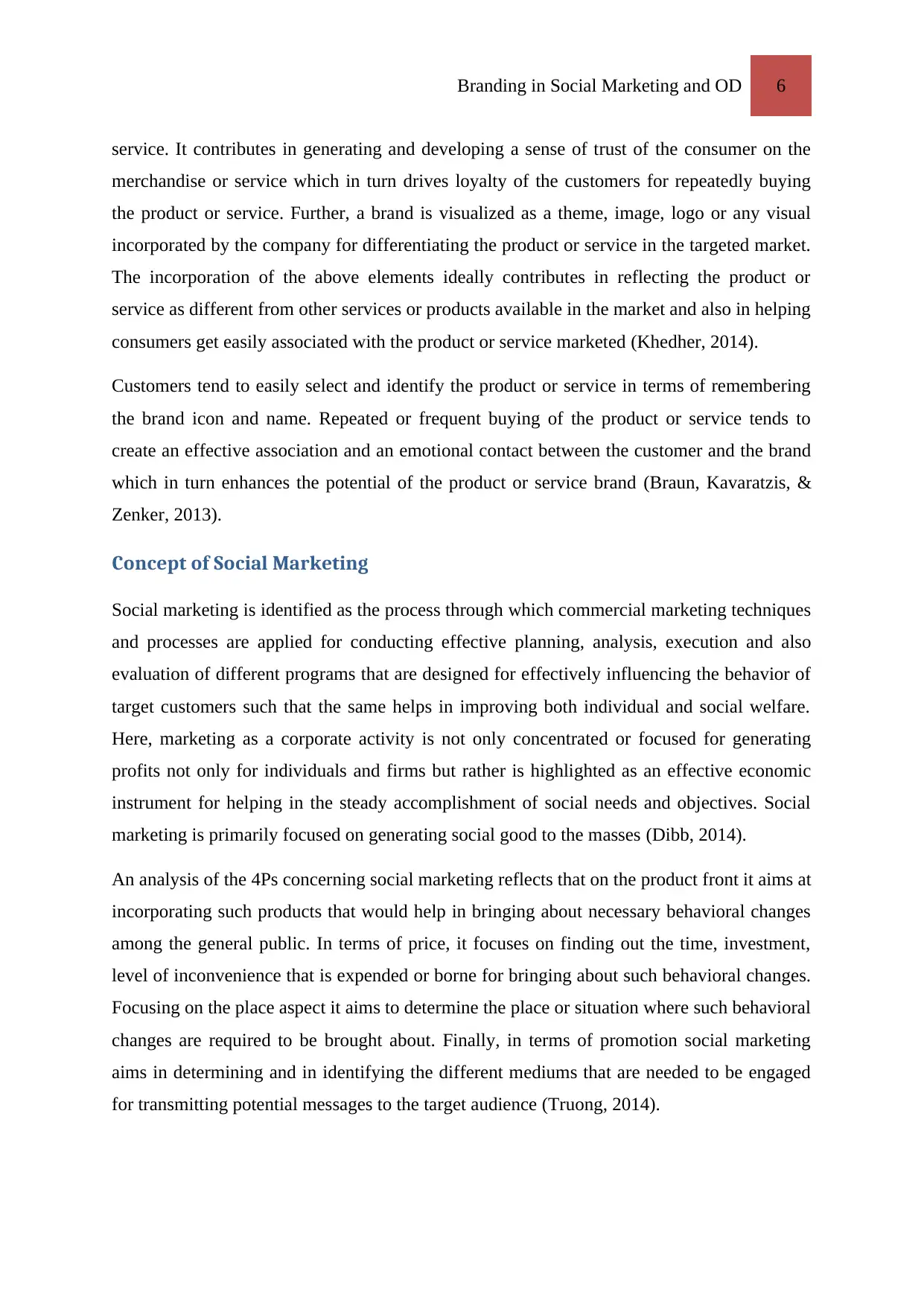
Branding in Social Marketing and OD 6
service. It contributes in generating and developing a sense of trust of the consumer on the
merchandise or service which in turn drives loyalty of the customers for repeatedly buying
the product or service. Further, a brand is visualized as a theme, image, logo or any visual
incorporated by the company for differentiating the product or service in the targeted market.
The incorporation of the above elements ideally contributes in reflecting the product or
service as different from other services or products available in the market and also in helping
consumers get easily associated with the product or service marketed (Khedher, 2014).
Customers tend to easily select and identify the product or service in terms of remembering
the brand icon and name. Repeated or frequent buying of the product or service tends to
create an effective association and an emotional contact between the customer and the brand
which in turn enhances the potential of the product or service brand (Braun, Kavaratzis, &
Zenker, 2013).
Concept of Social Marketing
Social marketing is identified as the process through which commercial marketing techniques
and processes are applied for conducting effective planning, analysis, execution and also
evaluation of different programs that are designed for effectively influencing the behavior of
target customers such that the same helps in improving both individual and social welfare.
Here, marketing as a corporate activity is not only concentrated or focused for generating
profits not only for individuals and firms but rather is highlighted as an effective economic
instrument for helping in the steady accomplishment of social needs and objectives. Social
marketing is primarily focused on generating social good to the masses (Dibb, 2014).
An analysis of the 4Ps concerning social marketing reflects that on the product front it aims at
incorporating such products that would help in bringing about necessary behavioral changes
among the general public. In terms of price, it focuses on finding out the time, investment,
level of inconvenience that is expended or borne for bringing about such behavioral changes.
Focusing on the place aspect it aims to determine the place or situation where such behavioral
changes are required to be brought about. Finally, in terms of promotion social marketing
aims in determining and in identifying the different mediums that are needed to be engaged
for transmitting potential messages to the target audience (Truong, 2014).
service. It contributes in generating and developing a sense of trust of the consumer on the
merchandise or service which in turn drives loyalty of the customers for repeatedly buying
the product or service. Further, a brand is visualized as a theme, image, logo or any visual
incorporated by the company for differentiating the product or service in the targeted market.
The incorporation of the above elements ideally contributes in reflecting the product or
service as different from other services or products available in the market and also in helping
consumers get easily associated with the product or service marketed (Khedher, 2014).
Customers tend to easily select and identify the product or service in terms of remembering
the brand icon and name. Repeated or frequent buying of the product or service tends to
create an effective association and an emotional contact between the customer and the brand
which in turn enhances the potential of the product or service brand (Braun, Kavaratzis, &
Zenker, 2013).
Concept of Social Marketing
Social marketing is identified as the process through which commercial marketing techniques
and processes are applied for conducting effective planning, analysis, execution and also
evaluation of different programs that are designed for effectively influencing the behavior of
target customers such that the same helps in improving both individual and social welfare.
Here, marketing as a corporate activity is not only concentrated or focused for generating
profits not only for individuals and firms but rather is highlighted as an effective economic
instrument for helping in the steady accomplishment of social needs and objectives. Social
marketing is primarily focused on generating social good to the masses (Dibb, 2014).
An analysis of the 4Ps concerning social marketing reflects that on the product front it aims at
incorporating such products that would help in bringing about necessary behavioral changes
among the general public. In terms of price, it focuses on finding out the time, investment,
level of inconvenience that is expended or borne for bringing about such behavioral changes.
Focusing on the place aspect it aims to determine the place or situation where such behavioral
changes are required to be brought about. Finally, in terms of promotion social marketing
aims in determining and in identifying the different mediums that are needed to be engaged
for transmitting potential messages to the target audience (Truong, 2014).
⊘ This is a preview!⊘
Do you want full access?
Subscribe today to unlock all pages.

Trusted by 1+ million students worldwide
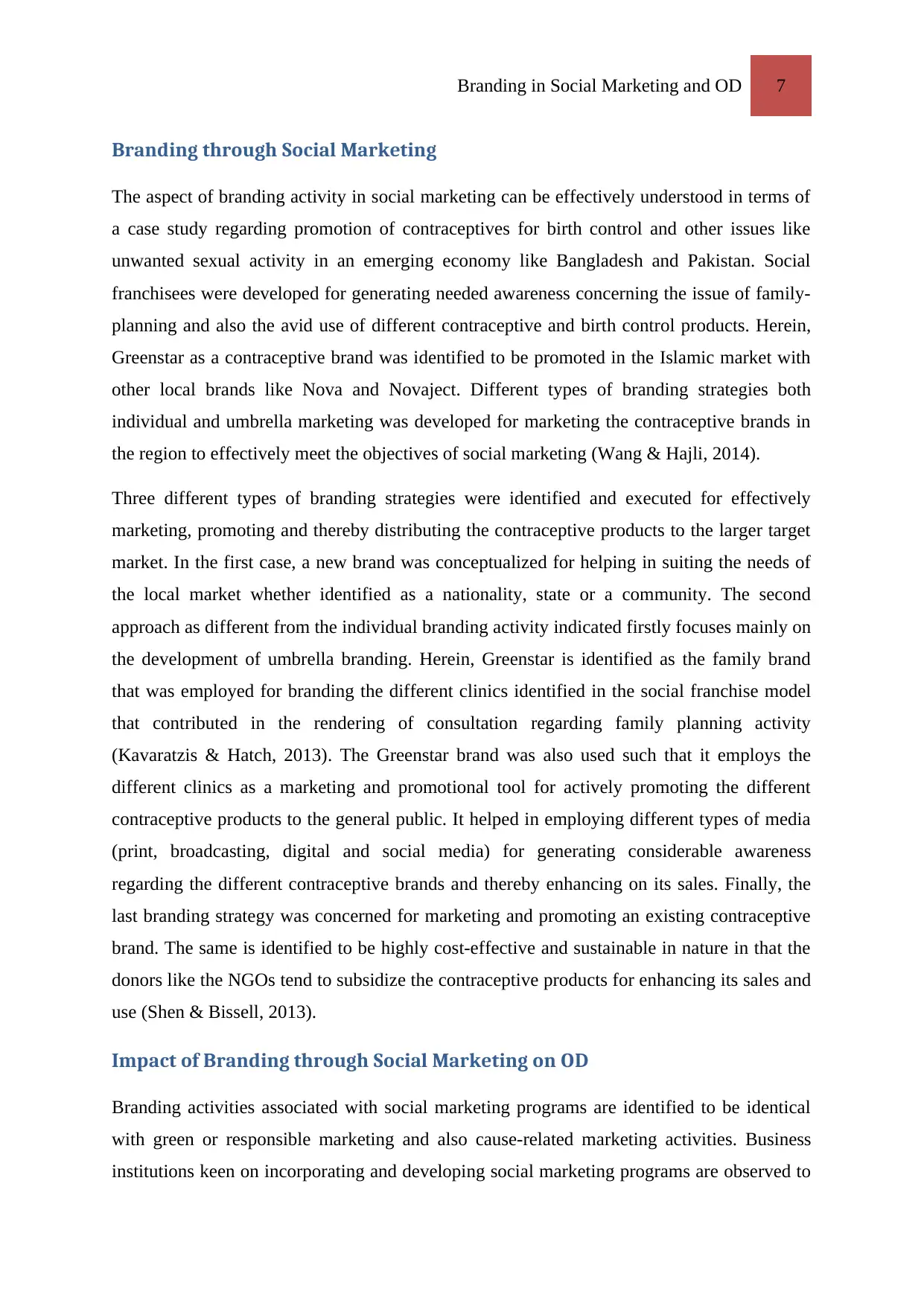
Branding in Social Marketing and OD 7
Branding through Social Marketing
The aspect of branding activity in social marketing can be effectively understood in terms of
a case study regarding promotion of contraceptives for birth control and other issues like
unwanted sexual activity in an emerging economy like Bangladesh and Pakistan. Social
franchisees were developed for generating needed awareness concerning the issue of family-
planning and also the avid use of different contraceptive and birth control products. Herein,
Greenstar as a contraceptive brand was identified to be promoted in the Islamic market with
other local brands like Nova and Novaject. Different types of branding strategies both
individual and umbrella marketing was developed for marketing the contraceptive brands in
the region to effectively meet the objectives of social marketing (Wang & Hajli, 2014).
Three different types of branding strategies were identified and executed for effectively
marketing, promoting and thereby distributing the contraceptive products to the larger target
market. In the first case, a new brand was conceptualized for helping in suiting the needs of
the local market whether identified as a nationality, state or a community. The second
approach as different from the individual branding activity indicated firstly focuses mainly on
the development of umbrella branding. Herein, Greenstar is identified as the family brand
that was employed for branding the different clinics identified in the social franchise model
that contributed in the rendering of consultation regarding family planning activity
(Kavaratzis & Hatch, 2013). The Greenstar brand was also used such that it employs the
different clinics as a marketing and promotional tool for actively promoting the different
contraceptive products to the general public. It helped in employing different types of media
(print, broadcasting, digital and social media) for generating considerable awareness
regarding the different contraceptive brands and thereby enhancing on its sales. Finally, the
last branding strategy was concerned for marketing and promoting an existing contraceptive
brand. The same is identified to be highly cost-effective and sustainable in nature in that the
donors like the NGOs tend to subsidize the contraceptive products for enhancing its sales and
use (Shen & Bissell, 2013).
Impact of Branding through Social Marketing on OD
Branding activities associated with social marketing programs are identified to be identical
with green or responsible marketing and also cause-related marketing activities. Business
institutions keen on incorporating and developing social marketing programs are observed to
Branding through Social Marketing
The aspect of branding activity in social marketing can be effectively understood in terms of
a case study regarding promotion of contraceptives for birth control and other issues like
unwanted sexual activity in an emerging economy like Bangladesh and Pakistan. Social
franchisees were developed for generating needed awareness concerning the issue of family-
planning and also the avid use of different contraceptive and birth control products. Herein,
Greenstar as a contraceptive brand was identified to be promoted in the Islamic market with
other local brands like Nova and Novaject. Different types of branding strategies both
individual and umbrella marketing was developed for marketing the contraceptive brands in
the region to effectively meet the objectives of social marketing (Wang & Hajli, 2014).
Three different types of branding strategies were identified and executed for effectively
marketing, promoting and thereby distributing the contraceptive products to the larger target
market. In the first case, a new brand was conceptualized for helping in suiting the needs of
the local market whether identified as a nationality, state or a community. The second
approach as different from the individual branding activity indicated firstly focuses mainly on
the development of umbrella branding. Herein, Greenstar is identified as the family brand
that was employed for branding the different clinics identified in the social franchise model
that contributed in the rendering of consultation regarding family planning activity
(Kavaratzis & Hatch, 2013). The Greenstar brand was also used such that it employs the
different clinics as a marketing and promotional tool for actively promoting the different
contraceptive products to the general public. It helped in employing different types of media
(print, broadcasting, digital and social media) for generating considerable awareness
regarding the different contraceptive brands and thereby enhancing on its sales. Finally, the
last branding strategy was concerned for marketing and promoting an existing contraceptive
brand. The same is identified to be highly cost-effective and sustainable in nature in that the
donors like the NGOs tend to subsidize the contraceptive products for enhancing its sales and
use (Shen & Bissell, 2013).
Impact of Branding through Social Marketing on OD
Branding activities associated with social marketing programs are identified to be identical
with green or responsible marketing and also cause-related marketing activities. Business
institutions keen on incorporating and developing social marketing programs are observed to
Paraphrase This Document
Need a fresh take? Get an instant paraphrase of this document with our AI Paraphraser
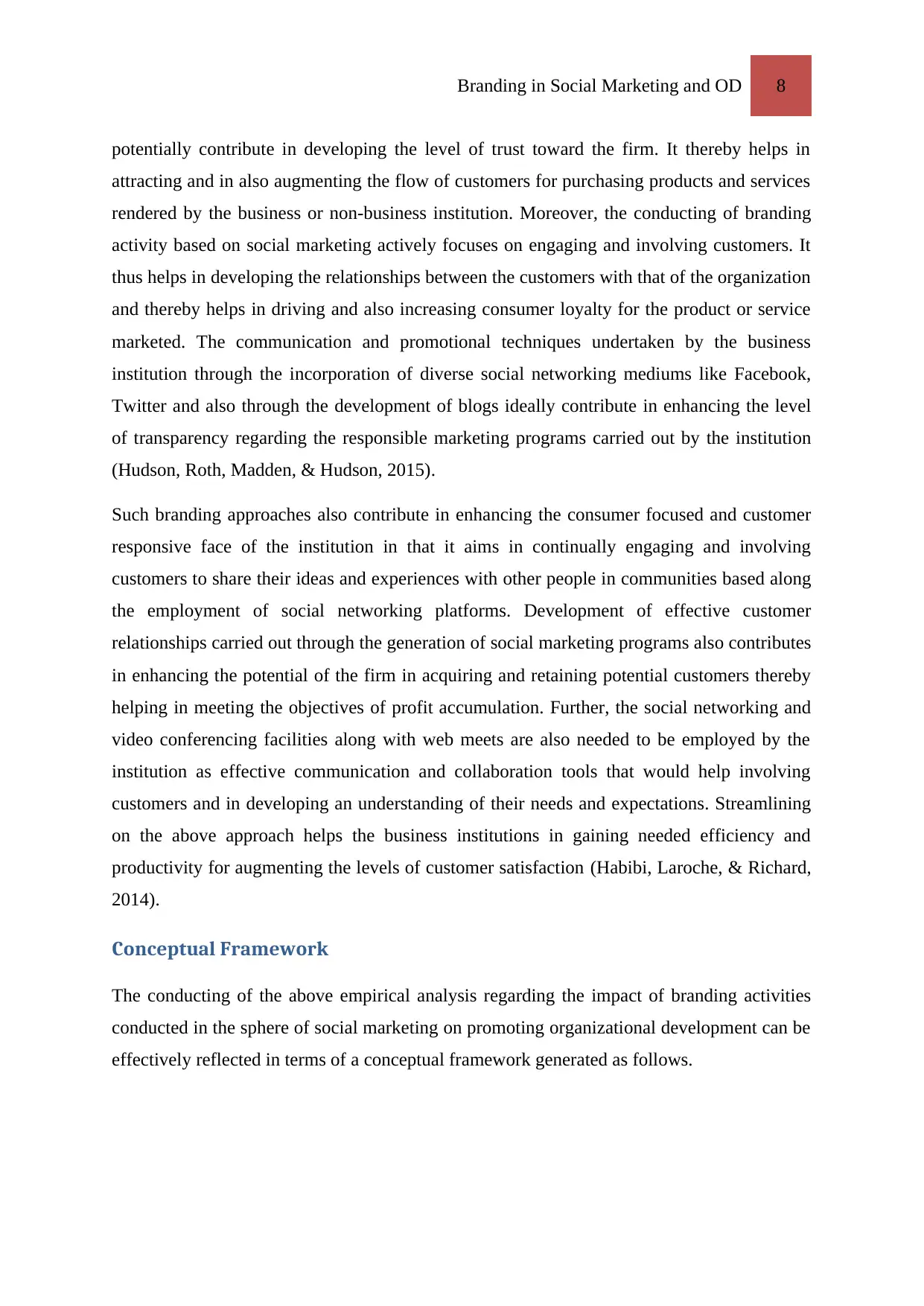
Branding in Social Marketing and OD 8
potentially contribute in developing the level of trust toward the firm. It thereby helps in
attracting and in also augmenting the flow of customers for purchasing products and services
rendered by the business or non-business institution. Moreover, the conducting of branding
activity based on social marketing actively focuses on engaging and involving customers. It
thus helps in developing the relationships between the customers with that of the organization
and thereby helps in driving and also increasing consumer loyalty for the product or service
marketed. The communication and promotional techniques undertaken by the business
institution through the incorporation of diverse social networking mediums like Facebook,
Twitter and also through the development of blogs ideally contribute in enhancing the level
of transparency regarding the responsible marketing programs carried out by the institution
(Hudson, Roth, Madden, & Hudson, 2015).
Such branding approaches also contribute in enhancing the consumer focused and customer
responsive face of the institution in that it aims in continually engaging and involving
customers to share their ideas and experiences with other people in communities based along
the employment of social networking platforms. Development of effective customer
relationships carried out through the generation of social marketing programs also contributes
in enhancing the potential of the firm in acquiring and retaining potential customers thereby
helping in meeting the objectives of profit accumulation. Further, the social networking and
video conferencing facilities along with web meets are also needed to be employed by the
institution as effective communication and collaboration tools that would help involving
customers and in developing an understanding of their needs and expectations. Streamlining
on the above approach helps the business institutions in gaining needed efficiency and
productivity for augmenting the levels of customer satisfaction (Habibi, Laroche, & Richard,
2014).
Conceptual Framework
The conducting of the above empirical analysis regarding the impact of branding activities
conducted in the sphere of social marketing on promoting organizational development can be
effectively reflected in terms of a conceptual framework generated as follows.
potentially contribute in developing the level of trust toward the firm. It thereby helps in
attracting and in also augmenting the flow of customers for purchasing products and services
rendered by the business or non-business institution. Moreover, the conducting of branding
activity based on social marketing actively focuses on engaging and involving customers. It
thus helps in developing the relationships between the customers with that of the organization
and thereby helps in driving and also increasing consumer loyalty for the product or service
marketed. The communication and promotional techniques undertaken by the business
institution through the incorporation of diverse social networking mediums like Facebook,
Twitter and also through the development of blogs ideally contribute in enhancing the level
of transparency regarding the responsible marketing programs carried out by the institution
(Hudson, Roth, Madden, & Hudson, 2015).
Such branding approaches also contribute in enhancing the consumer focused and customer
responsive face of the institution in that it aims in continually engaging and involving
customers to share their ideas and experiences with other people in communities based along
the employment of social networking platforms. Development of effective customer
relationships carried out through the generation of social marketing programs also contributes
in enhancing the potential of the firm in acquiring and retaining potential customers thereby
helping in meeting the objectives of profit accumulation. Further, the social networking and
video conferencing facilities along with web meets are also needed to be employed by the
institution as effective communication and collaboration tools that would help involving
customers and in developing an understanding of their needs and expectations. Streamlining
on the above approach helps the business institutions in gaining needed efficiency and
productivity for augmenting the levels of customer satisfaction (Habibi, Laroche, & Richard,
2014).
Conceptual Framework
The conducting of the above empirical analysis regarding the impact of branding activities
conducted in the sphere of social marketing on promoting organizational development can be
effectively reflected in terms of a conceptual framework generated as follows.
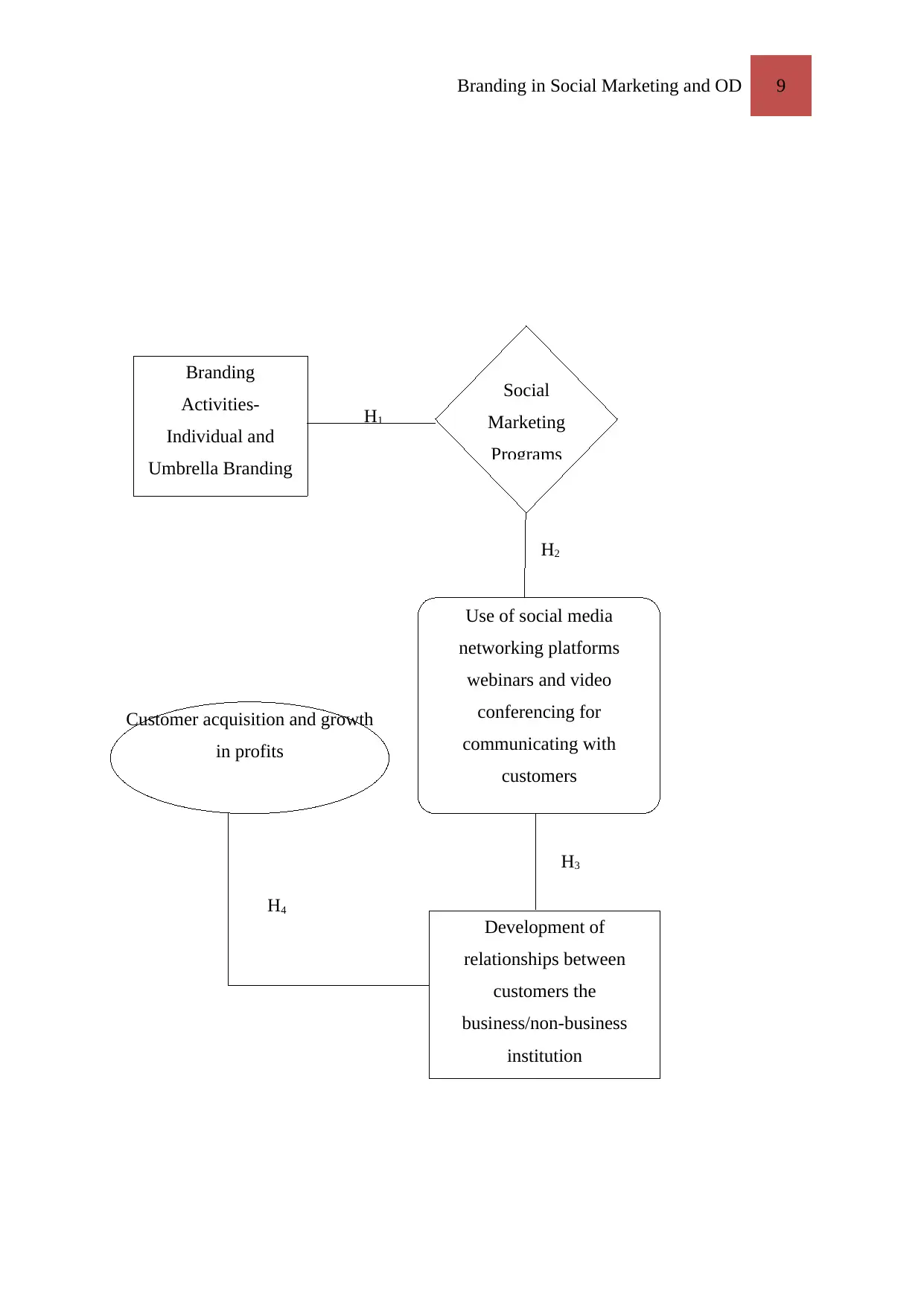
Branding in Social Marketing and OD 9
H1
H2
H3
H4
Branding
Activities-
Individual and
Umbrella Branding
Social
Marketing
Programs
Use of social media
networking platforms
webinars and video
conferencing for
communicating with
customers
Development of
relationships between
customers the
business/non-business
institution
Customer acquisition and growth
in profits
H1
H2
H3
H4
Branding
Activities-
Individual and
Umbrella Branding
Social
Marketing
Programs
Use of social media
networking platforms
webinars and video
conferencing for
communicating with
customers
Development of
relationships between
customers the
business/non-business
institution
Customer acquisition and growth
in profits
⊘ This is a preview!⊘
Do you want full access?
Subscribe today to unlock all pages.

Trusted by 1+ million students worldwide
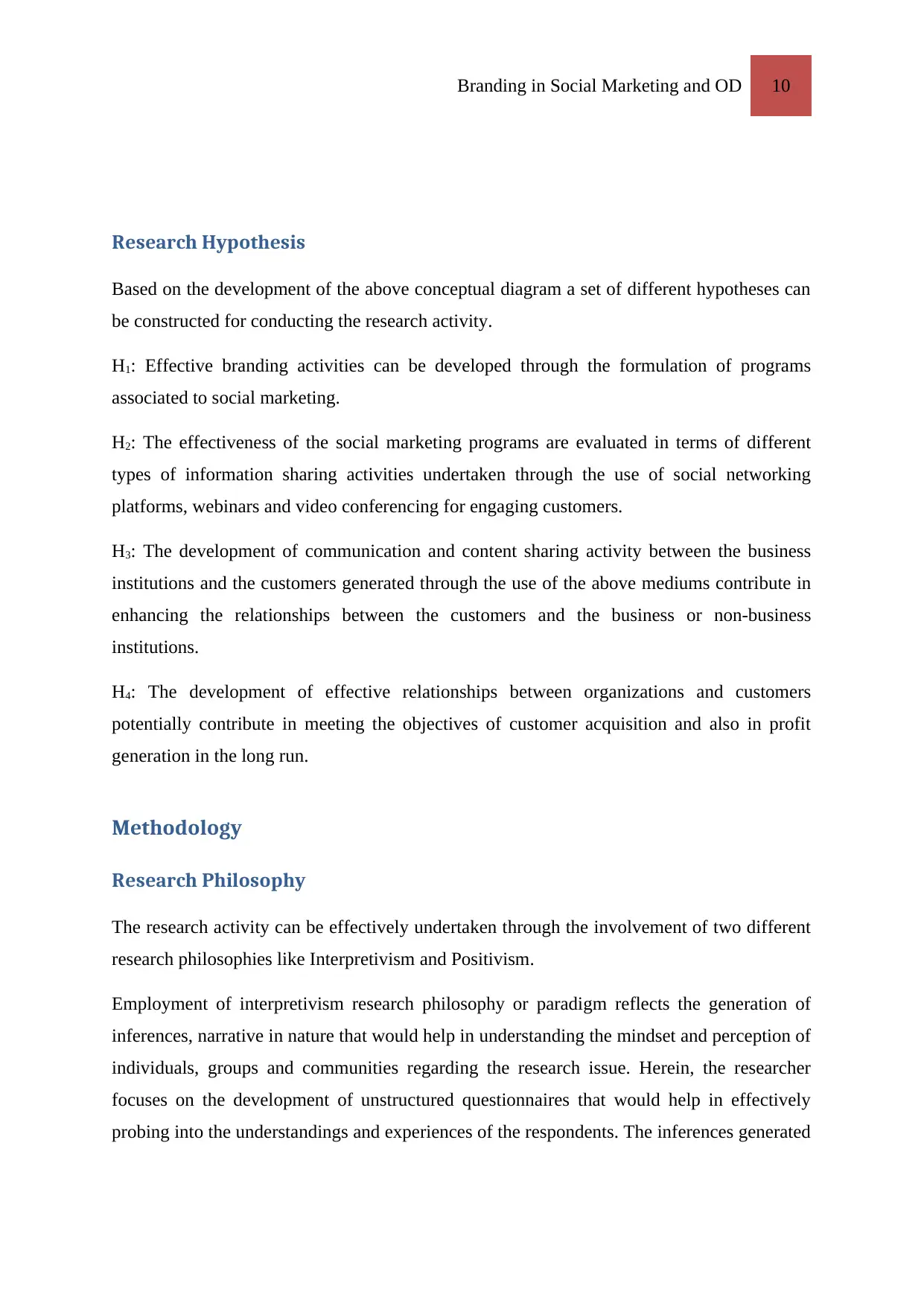
Branding in Social Marketing and OD 10
Research Hypothesis
Based on the development of the above conceptual diagram a set of different hypotheses can
be constructed for conducting the research activity.
H1: Effective branding activities can be developed through the formulation of programs
associated to social marketing.
H2: The effectiveness of the social marketing programs are evaluated in terms of different
types of information sharing activities undertaken through the use of social networking
platforms, webinars and video conferencing for engaging customers.
H3: The development of communication and content sharing activity between the business
institutions and the customers generated through the use of the above mediums contribute in
enhancing the relationships between the customers and the business or non-business
institutions.
H4: The development of effective relationships between organizations and customers
potentially contribute in meeting the objectives of customer acquisition and also in profit
generation in the long run.
Methodology
Research Philosophy
The research activity can be effectively undertaken through the involvement of two different
research philosophies like Interpretivism and Positivism.
Employment of interpretivism research philosophy or paradigm reflects the generation of
inferences, narrative in nature that would help in understanding the mindset and perception of
individuals, groups and communities regarding the research issue. Herein, the researcher
focuses on the development of unstructured questionnaires that would help in effectively
probing into the understandings and experiences of the respondents. The inferences generated
Research Hypothesis
Based on the development of the above conceptual diagram a set of different hypotheses can
be constructed for conducting the research activity.
H1: Effective branding activities can be developed through the formulation of programs
associated to social marketing.
H2: The effectiveness of the social marketing programs are evaluated in terms of different
types of information sharing activities undertaken through the use of social networking
platforms, webinars and video conferencing for engaging customers.
H3: The development of communication and content sharing activity between the business
institutions and the customers generated through the use of the above mediums contribute in
enhancing the relationships between the customers and the business or non-business
institutions.
H4: The development of effective relationships between organizations and customers
potentially contribute in meeting the objectives of customer acquisition and also in profit
generation in the long run.
Methodology
Research Philosophy
The research activity can be effectively undertaken through the involvement of two different
research philosophies like Interpretivism and Positivism.
Employment of interpretivism research philosophy or paradigm reflects the generation of
inferences, narrative in nature that would help in understanding the mindset and perception of
individuals, groups and communities regarding the research issue. Herein, the researcher
focuses on the development of unstructured questionnaires that would help in effectively
probing into the understandings and experiences of the respondents. The inferences generated
Paraphrase This Document
Need a fresh take? Get an instant paraphrase of this document with our AI Paraphraser
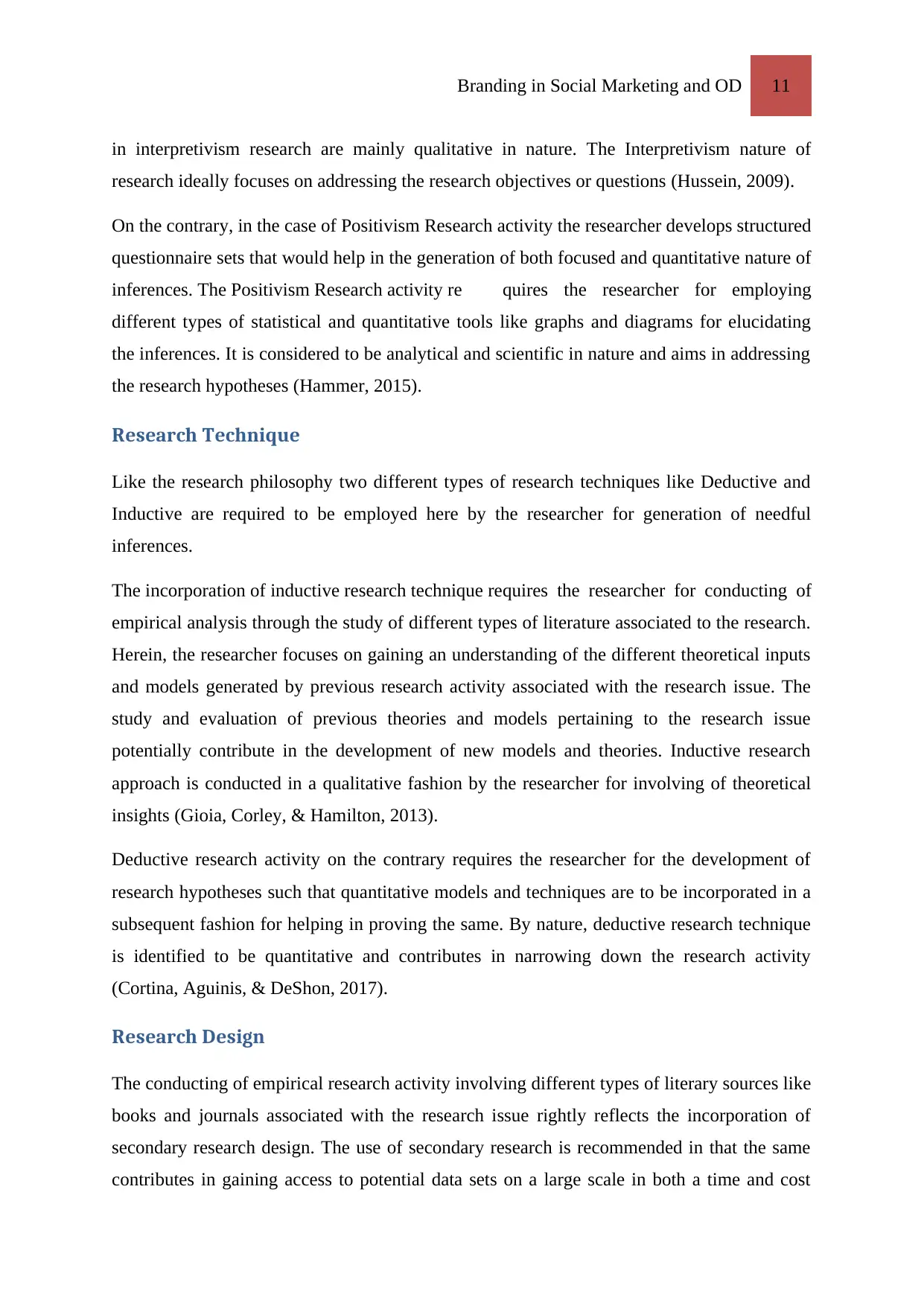
Branding in Social Marketing and OD 11
in interpretivism research are mainly qualitative in nature. The Interpretivism nature of
research ideally focuses on addressing the research objectives or questions (Hussein, 2009).
On the contrary, in the case of Positivism Research activity the researcher develops structured
questionnaire sets that would help in the generation of both focused and quantitative nature of
inferences. The Positivism Research activity re quires the researcher for employing
different types of statistical and quantitative tools like graphs and diagrams for elucidating
the inferences. It is considered to be analytical and scientific in nature and aims in addressing
the research hypotheses (Hammer, 2015).
Research Technique
Like the research philosophy two different types of research techniques like Deductive and
Inductive are required to be employed here by the researcher for generation of needful
inferences.
The incorporation of inductive research technique requires the researcher for conducting of
empirical analysis through the study of different types of literature associated to the research.
Herein, the researcher focuses on gaining an understanding of the different theoretical inputs
and models generated by previous research activity associated with the research issue. The
study and evaluation of previous theories and models pertaining to the research issue
potentially contribute in the development of new models and theories. Inductive research
approach is conducted in a qualitative fashion by the researcher for involving of theoretical
insights (Gioia, Corley, & Hamilton, 2013).
Deductive research activity on the contrary requires the researcher for the development of
research hypotheses such that quantitative models and techniques are to be incorporated in a
subsequent fashion for helping in proving the same. By nature, deductive research technique
is identified to be quantitative and contributes in narrowing down the research activity
(Cortina, Aguinis, & DeShon, 2017).
Research Design
The conducting of empirical research activity involving different types of literary sources like
books and journals associated with the research issue rightly reflects the incorporation of
secondary research design. The use of secondary research is recommended in that the same
contributes in gaining access to potential data sets on a large scale in both a time and cost
in interpretivism research are mainly qualitative in nature. The Interpretivism nature of
research ideally focuses on addressing the research objectives or questions (Hussein, 2009).
On the contrary, in the case of Positivism Research activity the researcher develops structured
questionnaire sets that would help in the generation of both focused and quantitative nature of
inferences. The Positivism Research activity re quires the researcher for employing
different types of statistical and quantitative tools like graphs and diagrams for elucidating
the inferences. It is considered to be analytical and scientific in nature and aims in addressing
the research hypotheses (Hammer, 2015).
Research Technique
Like the research philosophy two different types of research techniques like Deductive and
Inductive are required to be employed here by the researcher for generation of needful
inferences.
The incorporation of inductive research technique requires the researcher for conducting of
empirical analysis through the study of different types of literature associated to the research.
Herein, the researcher focuses on gaining an understanding of the different theoretical inputs
and models generated by previous research activity associated with the research issue. The
study and evaluation of previous theories and models pertaining to the research issue
potentially contribute in the development of new models and theories. Inductive research
approach is conducted in a qualitative fashion by the researcher for involving of theoretical
insights (Gioia, Corley, & Hamilton, 2013).
Deductive research activity on the contrary requires the researcher for the development of
research hypotheses such that quantitative models and techniques are to be incorporated in a
subsequent fashion for helping in proving the same. By nature, deductive research technique
is identified to be quantitative and contributes in narrowing down the research activity
(Cortina, Aguinis, & DeShon, 2017).
Research Design
The conducting of empirical research activity involving different types of literary sources like
books and journals associated with the research issue rightly reflects the incorporation of
secondary research design. The use of secondary research is recommended in that the same
contributes in gaining access to potential data sets on a large scale in both a time and cost
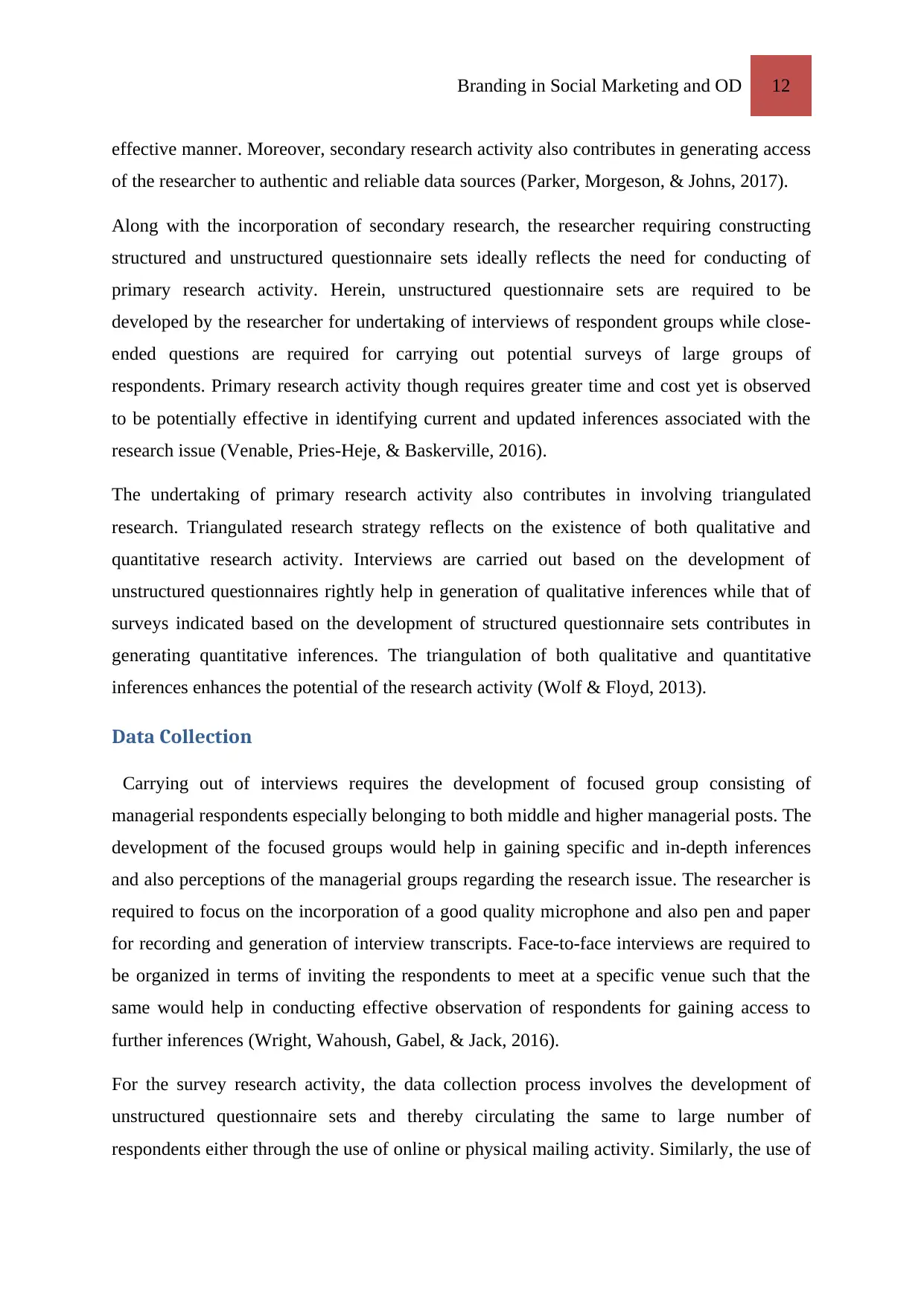
Branding in Social Marketing and OD 12
effective manner. Moreover, secondary research activity also contributes in generating access
of the researcher to authentic and reliable data sources (Parker, Morgeson, & Johns, 2017).
Along with the incorporation of secondary research, the researcher requiring constructing
structured and unstructured questionnaire sets ideally reflects the need for conducting of
primary research activity. Herein, unstructured questionnaire sets are required to be
developed by the researcher for undertaking of interviews of respondent groups while close-
ended questions are required for carrying out potential surveys of large groups of
respondents. Primary research activity though requires greater time and cost yet is observed
to be potentially effective in identifying current and updated inferences associated with the
research issue (Venable, Pries-Heje, & Baskerville, 2016).
The undertaking of primary research activity also contributes in involving triangulated
research. Triangulated research strategy reflects on the existence of both qualitative and
quantitative research activity. Interviews are carried out based on the development of
unstructured questionnaires rightly help in generation of qualitative inferences while that of
surveys indicated based on the development of structured questionnaire sets contributes in
generating quantitative inferences. The triangulation of both qualitative and quantitative
inferences enhances the potential of the research activity (Wolf & Floyd, 2013).
Data Collection
Carrying out of interviews requires the development of focused group consisting of
managerial respondents especially belonging to both middle and higher managerial posts. The
development of the focused groups would help in gaining specific and in-depth inferences
and also perceptions of the managerial groups regarding the research issue. The researcher is
required to focus on the incorporation of a good quality microphone and also pen and paper
for recording and generation of interview transcripts. Face-to-face interviews are required to
be organized in terms of inviting the respondents to meet at a specific venue such that the
same would help in conducting effective observation of respondents for gaining access to
further inferences (Wright, Wahoush, Gabel, & Jack, 2016).
For the survey research activity, the data collection process involves the development of
unstructured questionnaire sets and thereby circulating the same to large number of
respondents either through the use of online or physical mailing activity. Similarly, the use of
effective manner. Moreover, secondary research activity also contributes in generating access
of the researcher to authentic and reliable data sources (Parker, Morgeson, & Johns, 2017).
Along with the incorporation of secondary research, the researcher requiring constructing
structured and unstructured questionnaire sets ideally reflects the need for conducting of
primary research activity. Herein, unstructured questionnaire sets are required to be
developed by the researcher for undertaking of interviews of respondent groups while close-
ended questions are required for carrying out potential surveys of large groups of
respondents. Primary research activity though requires greater time and cost yet is observed
to be potentially effective in identifying current and updated inferences associated with the
research issue (Venable, Pries-Heje, & Baskerville, 2016).
The undertaking of primary research activity also contributes in involving triangulated
research. Triangulated research strategy reflects on the existence of both qualitative and
quantitative research activity. Interviews are carried out based on the development of
unstructured questionnaires rightly help in generation of qualitative inferences while that of
surveys indicated based on the development of structured questionnaire sets contributes in
generating quantitative inferences. The triangulation of both qualitative and quantitative
inferences enhances the potential of the research activity (Wolf & Floyd, 2013).
Data Collection
Carrying out of interviews requires the development of focused group consisting of
managerial respondents especially belonging to both middle and higher managerial posts. The
development of the focused groups would help in gaining specific and in-depth inferences
and also perceptions of the managerial groups regarding the research issue. The researcher is
required to focus on the incorporation of a good quality microphone and also pen and paper
for recording and generation of interview transcripts. Face-to-face interviews are required to
be organized in terms of inviting the respondents to meet at a specific venue such that the
same would help in conducting effective observation of respondents for gaining access to
further inferences (Wright, Wahoush, Gabel, & Jack, 2016).
For the survey research activity, the data collection process involves the development of
unstructured questionnaire sets and thereby circulating the same to large number of
respondents either through the use of online or physical mailing activity. Similarly, the use of
⊘ This is a preview!⊘
Do you want full access?
Subscribe today to unlock all pages.

Trusted by 1+ million students worldwide
1 out of 19
Related Documents
Your All-in-One AI-Powered Toolkit for Academic Success.
+13062052269
info@desklib.com
Available 24*7 on WhatsApp / Email
![[object Object]](/_next/static/media/star-bottom.7253800d.svg)
Unlock your academic potential
Copyright © 2020–2025 A2Z Services. All Rights Reserved. Developed and managed by ZUCOL.




